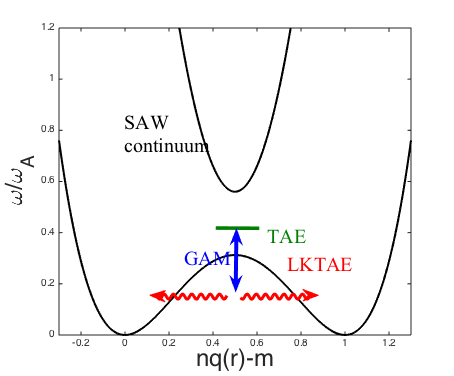Editor: Becky Time: 2018-04-02 Number of visits: 108
Confined fusion provides the ultimate solution of energy. In a fusion reactor, alpha particles as the fusion product, heat the fuel deuterium and tritium ions, leading to self-sustained burning and effective power gain. Alpha particle related physics is thus, a key issue in the steady state operation of reactors, and consequently, one of the frontiers in fusion plasma research. Alpha particles can excite symmetry breaking collective instabilities through wave-particle resonant interactions, e.g., Toroidal Alfven eigenmode (TAE), leading to alpha particle radial transport and loss, degradation of both alpha particles and thermal plasma confinement, and potential damage to plasma facing components.
Zhiyong Qiu and Liu Chen from institute for fusion theory and simulation (IFTS), proposed a new mechanism for TAE nonlinear saturation, through decaying into toroidally symmetric geodesic acoustic mode (GAM) and propagating kinetic TAE (KTAE). The secondary KTAE and GAM, can heat thermal electrons and ions, respectively, leading to alpha particle anomalous slowing down and fuel ions heating, i.e., the famous alpha-channeling. The presented first principle based kinetic theory shows that, the proposed decay channel has finite cross-section in the burning plasma relevant parameter regime, and thus, can play an important role for the fusion performance. The corresponding TAE saturation level and plasma heating rate are estimated from the obtained coupled TAE-GAM-KTAE triad equations. One byproduct of this process is that, GAM as the finite frequency zonal flow, can regulate turbulences, resulting in improved thermal plasma confinement. A number of interesting implications that can be explored in greater detail in the near future, both numerically and experimentally, are also suggested.
This paper is published in Phyical review letters 120, 135001 (2018). The authors are Profs. Zhiyong Qiu, Liu Chen from IFTS, Prof. Fulvio Zonca from ENEA Frascati research center, Italy, and Prof. Wei Chen from southwestern institute of physics, China. Links to the paper: https://journals.aps.org/prl/abstract/10.1103/PhysRevLett.120.135001


Add: No. 8 Hainayuan Building, Zijingang Campus, Zhejiang University, 866 Yuhangtang Rd, Hangzhou, 310027, P.R. China
Tel: +86-571-87953325
Fax: +86-571-87951895
Email: yongyi@zju.edu.cn